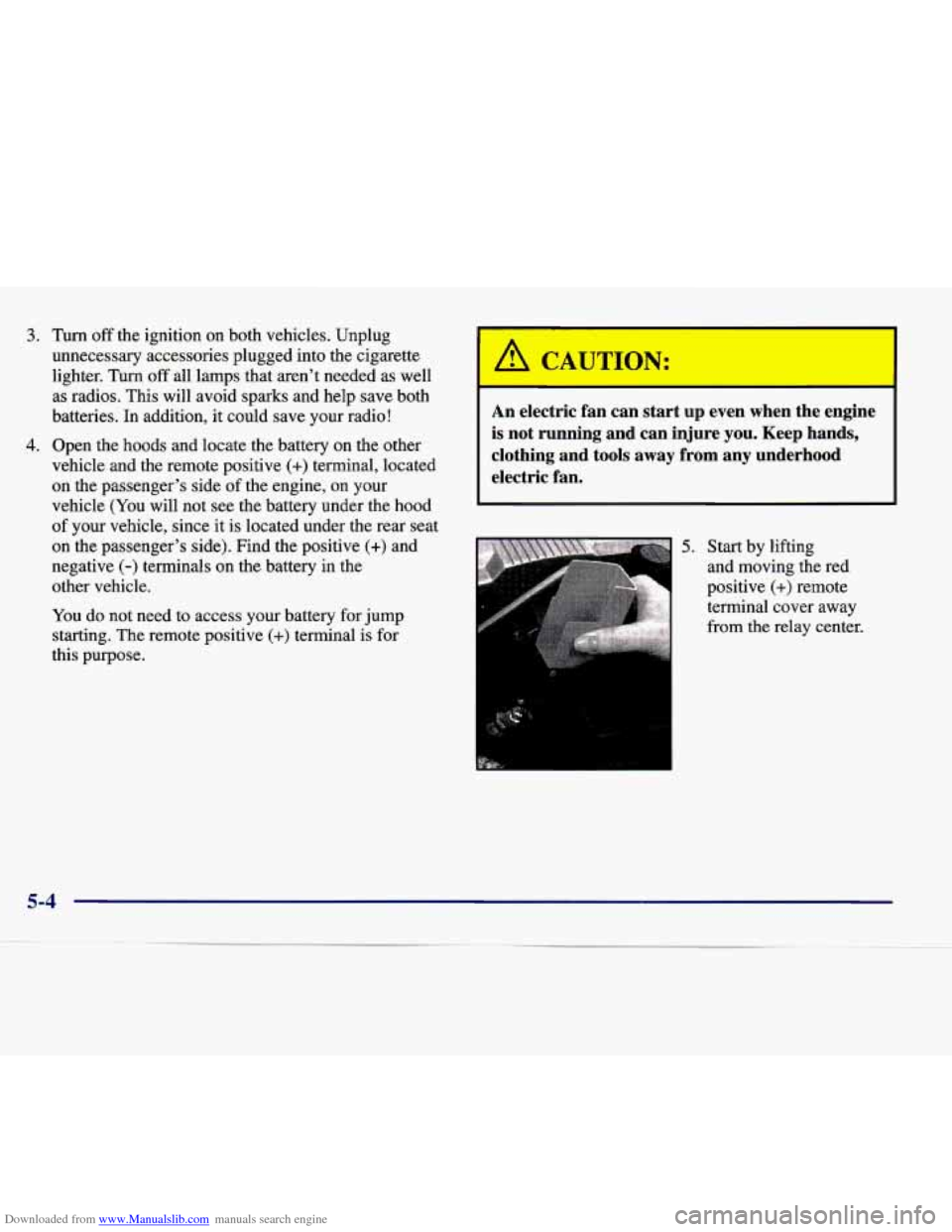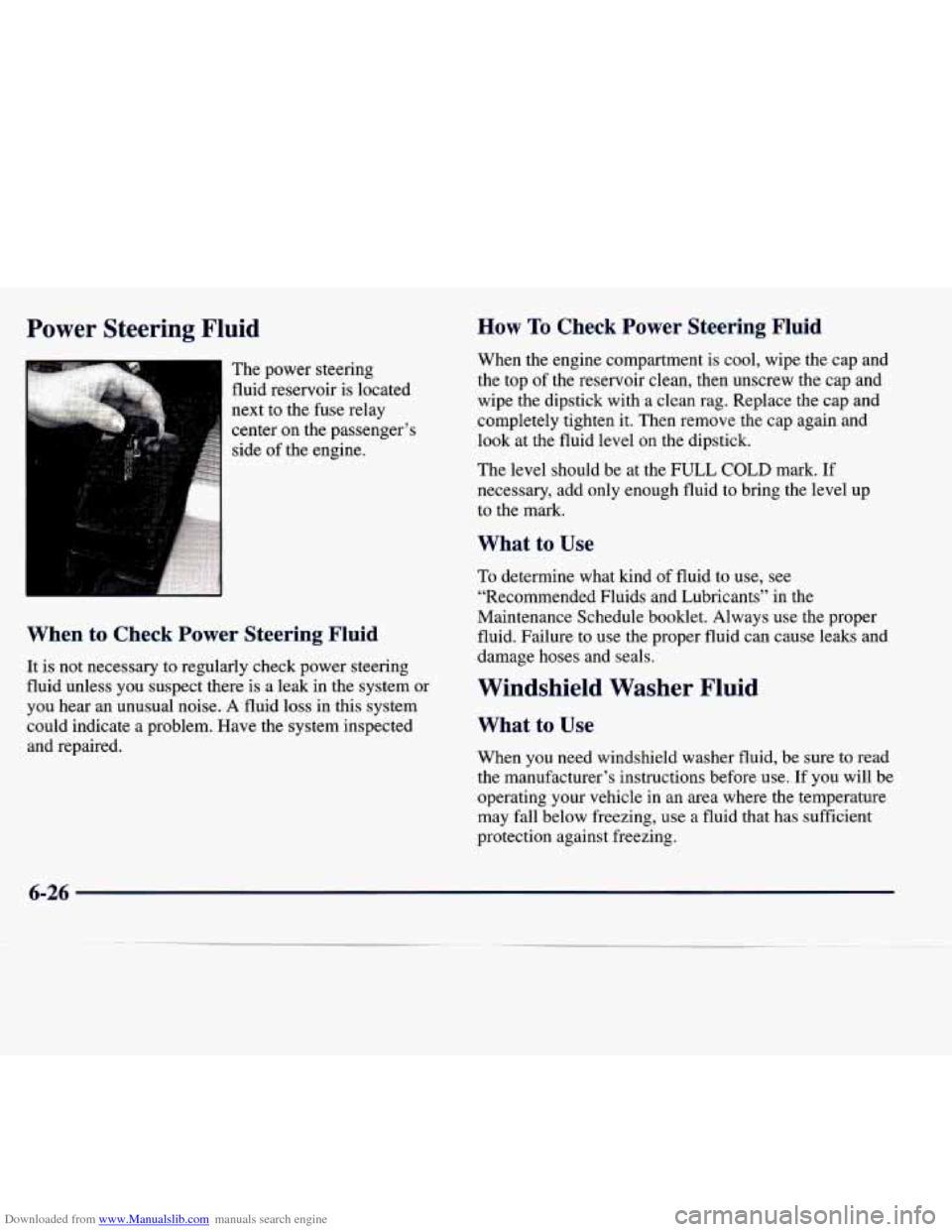Page 241 of 378

Downloaded from www.Manualslib.com manuals search engine 3. Turn off the ignition on both vehicles. Unplug
unnecessary accessories plugged into the cigarette
lighter. Turn
off all lamps that aren’t needed as well
as radios. This will avoid sparks and help save both
batteries. In addition’ it could save your radio!
4. Open the hoods and locate the battery on the other
vehicle and the remote positive
(+) terminal’ located
on the passenger’s side
of the engine, on your
vehicle (You will not see the battery under the hood
of your vehicle, since it is located under the rear seat
on the passenger’s side). Find the positive
(+) and
negative
(-) terminals on the battery in the
other vehicle.
You do not need to access your battery for jump
starting. The remote positive
(+) terminal is for
this purpose.
A CAUTION:
An electric fan can start up even when the engine
is not running and can injure you. Keep hands,
clothing and tools away from any underhood
electric fan.
5. Start by lifting
and moving the red
positive
(+) remote
terminal cover away
from the relay center.
c
5-4
Page 301 of 378

Downloaded from www.Manualslib.com manuals search engine Power Steering Fluid
The power steering
fluid reservoir is located
next to the fuse relay
center on the passenger’s
side of the engine.
When to Check Power Steering Fluid
It is not necessary to regularly check power steering
fluid unless you suspect there
is a leak in the system or
you hear an unusual noise. A fluid loss in this system
could indicate a problem. Have the system inspected
and repaired.
How To Check Power Steering Fluid
When the engine compartment is cool, wipe the cap and
the top of the reservoir clean, then unscrew the cap and
wipe the dipstick with a clean rag. Replace the cap and
completely tighten it. Then remove the cap again and
look at the fluid level on the dipstick.
The level should be at the
FULL COLD mark. If
necessary, add only enough fluid
to bring the level up
to the mark.
What to Use
To determine what kind of fluid to use, see
“Recommended Fluids and Lubricants” in the
Maintenance Schedule booklet. Always use the proper
fluid, Failure
to use the proper fluid can cause leaks and
damage hoses and seals.
Windshield Washer Fluid
What to Use
When you need windshield washer fluid, be sure to read
the manufacturer’s instructions before use.
If you will be
operating your vehicle
in an area where the temperature
may fall below freezing, use a fluid that has sufficient
protection against freezing.
6-26
Page 302 of 378
Downloaded from www.Manualslib.com manuals search engine Adding Washer Fluid
The windshield washer fluid reservoir is located next to
the fuse relay center on the passenger’s side of
the engine.
Open the cap labeled WASHER
FLUID. Add washer
fluid until the tank is
full.
NOTICE:
0
0
0
0
When using concentrated washer fluid,
follow the manufacturer’s instructions for
adding water.
Don’t
mix water with ready-to-use washer
fluid. Water can cause the solution to freeze
and damage your washer fluid tank and
other parts of the washer system. Also,
water doesn’t clean
as well as washer fluid.
Fill your washer fluid tank only
three-quarters full when
it’s very cold. This
allows for expansion
if freezing occurs,
which could damage the tank
if it is
completely full.
Don’t use engine coolant (antifreeze) m
your windshield washer.
It can damage
your washer system and paint.
6-27
Page 337 of 378
Downloaded from www.Manualslib.com manuals search engine Micro Relays Relay Usage
27 Headlamp High Beam
28 Headlamp
Low Beam
29 Fog Lamps
30 Daytime Running Lamps
31 Horn
32 Air Conditioner Clutch
Mini Relays
Relay Usage
33 Not Used
34 Accessory
35 Starter 2
36 Starter 1
37 Cooling Fan Secondary
39 Cooling Fan SeriesParallel
38 Ignition 1
40 Cooling Fan Primary
Maxibreaker Circuit Usage
Breaker
41 Starter
Maxifuses
Fuse Usage
42 Not Used
43 Export Brake
45 Antilock Brake System Motor
47 Cooling Fan Primary
44 Antilock Brake System Solenoid
46 Cooling Fan Secondary
The spare fuses are located in numbers 48 through 52.
The fuse puller is located in number
53.
6-62
Page 340 of 378
Downloaded from www.Manualslib.com manuals search engine Micro Relays Relay
39
40 41
42
43
44
45
46
47
48
49
50
51
52
53
54
55
Usage
Fuel Pump
Parking Lamps Ignition
1
Park Brake A
Park Brake B
Park Shift Interlock
Reverse Lamps
Retained Accessory Power for Sunroof
Rear HVAC Blower
CVRSS Dampers
Ignition
3
Fuel Tank Door Release
Interior Lamps
Trunk Release
Front Courtesy Lamps
Rear Courtesy Lamps
Electronic Level Control Compressor
Circuit Breakers
Relay Usage
56 Power Seats
57 Power Windows
Mini Relays
Relay Usage
58 Cigarette Lighter
59 Rear Defog
Maxifuses Fuse Usage
60 Park Brake
61 Rear Defog
62 Not Used
63 Audio Amplifier
64 ELC CompressorExhaust
65 Cigar Lighter
66 Not Used
The spare fuses are located in numbers
67 through 74.
The fuse puller is located in number 75.
6-65
Page 342 of 378
Downloaded from www.Manualslib.com manuals search engine Removing the Rear Seat Cushion
NOTICE:
The battery and main fuse boxes are located
under the rear seat cushion. The battery’s ground
terminal and some relay wires are exposed.
To
help avoid damage to the battery and wires, be
careful when removing or reinstalling the seat
cushion.
Do not remove covers from covered
parts.
Do not store anything under the seat, as
objects could touch exposed wires and cause
a short.
To Remove the Rear Seat Cushion
1. Pull up on the front of the cushion to release the
front
hooks.
2. hll the cushion up and out toward the front of
the vehicle.
To Reinstall the Rear Seat Cushion
A safety belt that isn’t properly routed through
the seat cushion or is twisted won’t provide the
protection needed in a crash.
If the safety belt
CAUTION: (Continued)